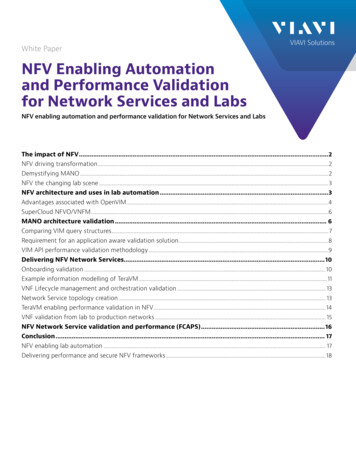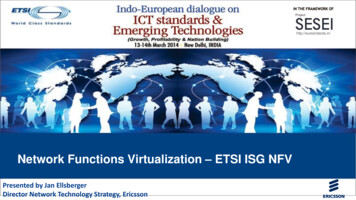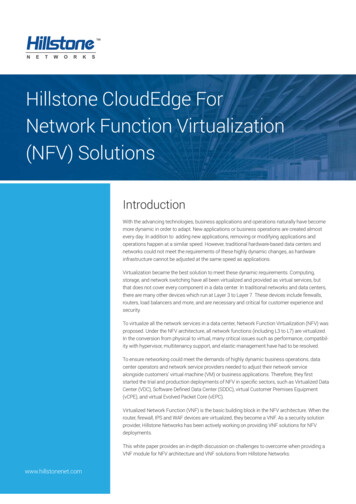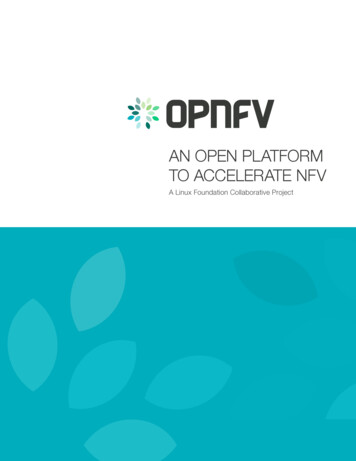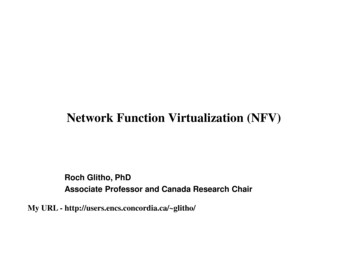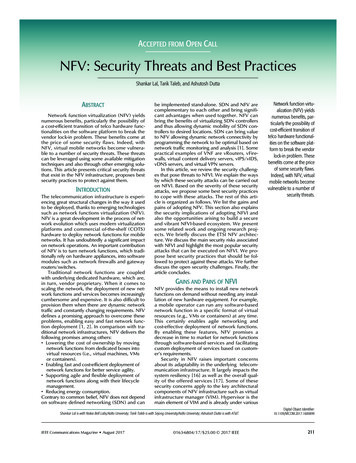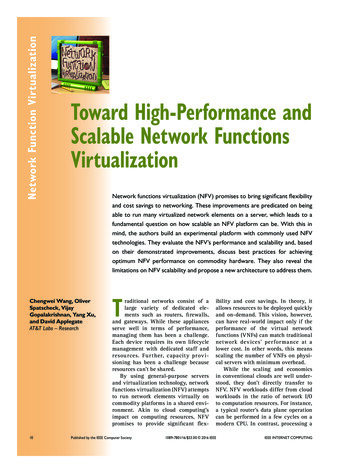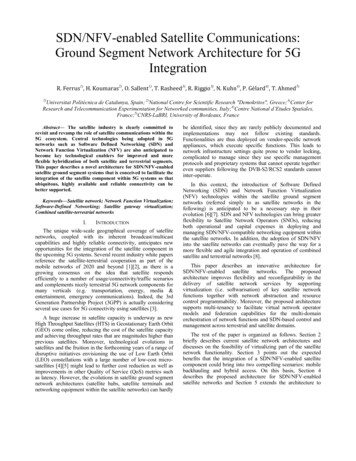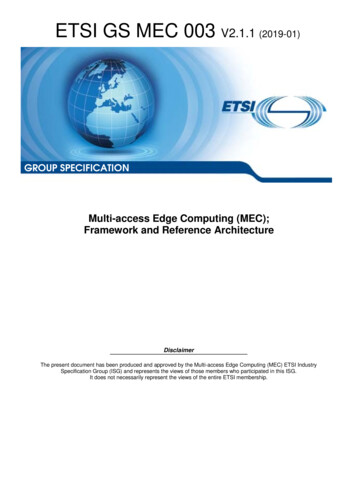
Transcription
Enabling Network Function Virtualization (NFV)Transformation for Communications ServiceProviders
Enabling NFV Transformation for Communications Service ProvidersRethinking the telecom networkCommunications Service Providers (CSPs) are at a turning point, with increased pressure caused by sky-rocketingdemand (mobile data traffic, bandwidth, app usage, customization ) and aggressive competition represented byalternative service providers who are taking advantage of the network to launch new services (such as third partycommunication applications) at unprecedented speed. CSPs need to react and find a way to create a competitiveadvantage in the digital era, but they are also facing constraints from their legacy network, such as increasing CapExand OpEx, complexity and inflexibility, creating an outdated service delivery environment.Cloud and software are part of the answer as they constitute the DNA of NFV (Network Function Virtualization) andSDN (Software Defined Networking) technologies, unleashing yet another major Telco transformation with impactscomparable to the IP revolution. While NFV enables quick creation and deployment of innovative new services basedon chained virtualized functions, SDN simplifies the way data is orchestrated to activate and manage these services.Still, while these new technologies are driving this disruption, with many technical challenges already fully occupyingCSPs as they PoC, trial and deploy, their adoption alone will not suffice in delivering business promises of great time-tomarket, new revenue streams and reduced total cost of ownership. Indeed, the agility, flexibility and innovative mindsetneeded by CSPs to unlock these opportunities can only be provided by conceding a major change of their networkoperations and organization, which need to be aligned with this new software paradigm. NFV and SDN will lead CSPsto re-think entirely the way their network is conceived and operated, as well as monetized. They will introduce newprocesses and mark the entrance of IT concepts and practices in the Network domain, to the extent of creating serviceoriented, customer-centric, software-defined CSPs, armed to build the digital advantage.NFV at a glanceCSPs are building their roadmaps.AT&T plans to have 75% of its network virtualized by 2020A growing MarketThe SDN and NFV market is forecasted to grow at86% CAGR. It will grow from approximately USD 2Billion in 2015 to USD 45 Billion in 202045.64GR6%8CA24.54.and expect major benefitsFlexible capacity management tosupport increasing data trafficFrom 37.4 Exabytes in 2013 to125 Exabytes in 2017Agility to launch new high valueservices.From less than 150 MillionVoLTE subscribers in 2015 tomore than 600 Million in 2018.With accelerated time-tomarket and provisioning cyclesVoLTE deployment in 3.5 hours(compared to 6 months in nonvirtualized network)Network on Demand reducesprovisioning cycles by 80% to90%Operational efficiency10% network operationalspending gains due toautomation and simplification63% network operationalspending gains with virtualizedCPE compared to traditionalCPEReduced hardware investmentsHardware spending from 101Bin 2013 to 18.5B in 202313.197.093.812.0520152016201720182019CAGR Compound Annual Growth Rate2020Source: ReportsnReports, Analysys Mason, IDC, ACG Research, Capgemini Consulting analysis2
Enabling NFV Transformation for Communications Service ProvidersThe challenges of NFVCSPs face many significant challenges when driving implementation of NFV. Some of these challenges are related totechnology, especially due to current maturity of solutions available in the market. Nevertheless, as technology rapidlymatures, operational, organizational and transformational challenges become the most relevant challenges for NFVimplementationBased on our analysis and lessons learned, below is a synthesis of the major challenges awaiting CSPs:Understanding the Business Case including overall benefits and transformation costsDefining the right Roadmap & Governance to benefit from NFV transformation while controlling risksTechnicalEnsuring carrier-grade performance andsecurity in virtualized functionsDealing with current lack of maturity ofsolutionsManaging a complex set of solutions,vendors, environmentsEnsuring integration: end-to-end view ofservices, interoperability across virtualsolutions and legacyOperationalOrganizationalRevamping service lifecycle managementand procurement to realize time-tomarket benefitsTransforming organizational structure ofNetwork areaCreating MANO processes for virtualizednetworkingDeveloping new skills for new rolesAdapting O&M processes to NFV toensure end-to-end performanceTransforming OSS to deal withvirtualized functionsDealing with both virtualized andphysical functions (hybrid)Redefining engagement models withNetwork & IT suppliersChanging culture in network from HWto SW, Agile and DevOpsHow CSPs can address these challengesAt the technological level, we believe the challenge for CSPs is to set up, design and implement a simplified networkarchitecture by defining the adapted strategy for their new virtualized infrastructure and by prioritizing use cases in acomprehensive approach to deliver expected NFV benefits. CSPs need to make complex choices at all levels of theETSI-defined NFV architecture with integration, interoperability and performance considerations.At the operational level, CSPs need to adopt a seamless operating model, inspired by Cloud practices, which isservice-driven, in line with business requirements and vision, and enabling cross-collaboration. The way in which thenew architecture will impact the operations and delivery model is key.At the organizational level, CSPs need to structure an evolved organizational structure to support the new operatingmodel and embrace the new software mindset brought by NFV, with silos between Network teams and IT teamscollapsed to deliver agility. People transformation is completed by new profiles and skills and a new culture that fitswith the ambition and model of the CSP.3
Enabling NFV Transformation for Communications Service ProvidersFraming the NFV transformationStructuring a NFV transformation program based on a dedicated frameworkCapgemini believes the NFVtransformationshouldbeapproached by CSPs as a holisticcompany transformation, so that thenetwork, organization, operations,culture and business model arealigned to create a competitiveadvantage. With this convictionin mind, we have defined an NFVtransformation framework, based on5 dimensions, designed to structurea global transformation programand accelerate NFV adoption atCSPs, tackling all of the challengesmentioned above.GovernanceChange planTechnological RoadmapGovernance& RoadmapProgram managementStrategic planBusiness caseBusiness modelsPoCs and trialsBusiness& ating modelNetwork operationsMANOOSS / BSSLab perationsOrganization& SkillsDevOps/ AgileCultureSkillsTransformation Governance & Roadmap:Build a corporate level NFV transformation program with the right governance model that includes all stakeholders(Network, IT, HR, Finance, Marketing, Sales), and a roadmap.Business and strategy:Assess time to market drivers, procurement and investment approach, OPEX/CAPEX drivers, costing/pricing models,and NFV-based services strategy. Build the NFV global business case, assessing top line (faster time to revenue, newrevenue streams) and bottom line (Total Cost of Ownership analysis, including transformation costs and platform)costs.Technology:Foster internal learning, ensure NFV-compliance of technology, define best model for platform architecture, andinvolvement in standardization and open-source initiatives.Operations:Define new operating model, engineer new processes and adapt existing processes, and transform OSS/BSS.Organization and skills:Manage cu
Cloud and software are part of the answer as they constitute the DNA of NFV (Network Function Virtualization) and SDN (Software Defined Networking) technologies, unleashing yet another major Telco transformation with impacts comparable to the IP revolution. While NFV enables quick creation and deployment of innovative new services based on chained virtualized functions, SDN simplifies the way .

